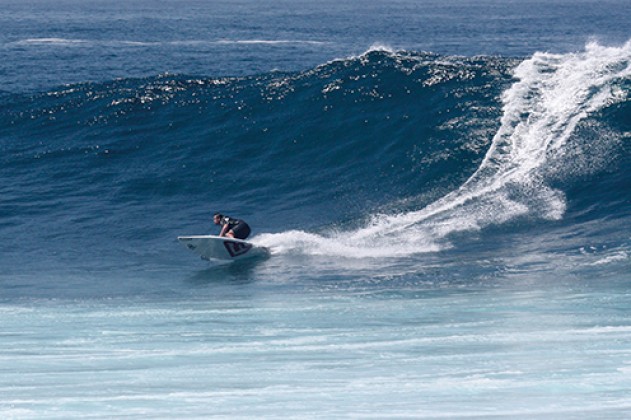BIG WAVE GUNS
With Rob Small
We all know the sort of day. The salt spray hangs in the air, thick like an early summer sea mist. The distant rumble and crack of breaking waves constantly remind you of the escalation from recreational to something more serious. Grown men are strangely quiet, or perhaps too gregarious and covering their fear with banter, or just calm and focused, pulling sleek fit for purpose, serious looking boards from bags and vans. Enter The Gun.
By definition a gun is designed to deal with bigger and heavier surf conditions, and just owning one speaks of a desire and commitment to tackle such conditions, providing you actually ride it of course! Perhaps the first problem we face is, knowing when to ride our gun. Regular day to day stand up paddle boards often cover a greater range of surf conditions than, let’s say, a 6’2” shortboard. To give you a concrete example, I like to ride Fanatic’s Pro wave Range. My board of choice from knee high to well over head is an: 8’6” x 28’ ¾” at 110 litres of volume. My gun is the 9’9” Semi Gun at: 9’9” x 28’6” at 131 litres of volume. The 8’6” will handle some pretty serious surf, even double or triple overhead waves of the magnitude of El Quemao or Thurso East. So I’m still riding the same board that I’d ride at 2ft beachbreak in some real juice.
Design principles
With its increase in volume and straighter rail line, one of the advantages the 9’9” gives me is in paddle speed and power. Paddling long distances to outside peaks, negotiating current and chop and increased mobility in the line-up all make the gun well to suited to big waves breaking over large areas with lots of water movement, where paddling comfort and performance become paramount.
These same attributes are also invaluable at the business end of the deal: catching waves. With speed and commitment you should be able to get up to wave catching velocity, in and over the edge earlier, and so more safely, that on smaller equipment. However be aware that these same design features, higher volume, straighter template, narrower tail, will require you to pick the best line into the take off and commit to it much earlier than you would on your smaller board. Last minute adjustments are going to be more problematic and possibly much more costly than at the local beachbreak. Paddle wise I tend to use a long stroke as the wave approaches and switch to shorter more explosive strokes once the wave rises under me.
Riding it
Ok, so now we’re in and going. Expect abrupt speed, quite possibly bumps and lumps and big chucks of lip chasing you. Keep your stance low, solid and flexible. You’re going to have to absorb a lot of bounce through the legs (unless it’s super glassy) and get a good bottom turn in. It’s the key to successfully negotiating your bomb.
Coming in to the bottom turn make sure you place it well. Too close to the wave face and you’re going to meet the lip, too far out on the flats and you won’t make the section. Don’t over think it, trust your instinct and experience and commit 100%. Your paddle will be invaluable here, don’t just surf the board as it won’t come round like a smaller SUP or surfboard. I reach forward and plant the paddle forward along my inner rail and let the board turn around this point. You may have to have the paddle in the water for longer than in smaller waves and don’t be afraid to put a good bit of weight on it, it’s not only helping the board through the turn but giving you stability at a critical juncture. Keep a good grip and make sure the paddle is out as the inner rail disengages and the board come out of the bottom turn…you’ve made the drop, come round the bottom and are on the home straight!
INSIDER TRADING…
1. Ride your gun in normal conditions before you have a go at huge Sunset. Going into big waves on untested kit is sketchy to say the least.
2. Think about your entry and exit points, big boards, paddles, long leashes, walls of white water all add up to potential problems.
3. Check your kit over before going in. Fin bolts, leash string and swivels. You don’t want to swim miles for being lazy.
4. Slow is Pro!
5. Safety first. Not just yours but those around you. Take appropriate action in each situation to ensure everyone is safe.

